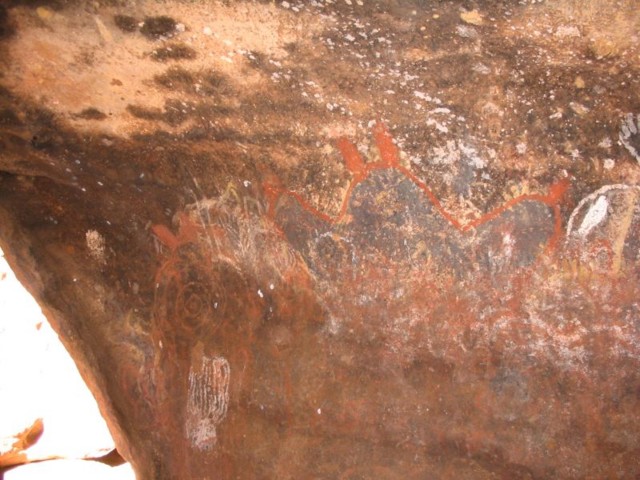
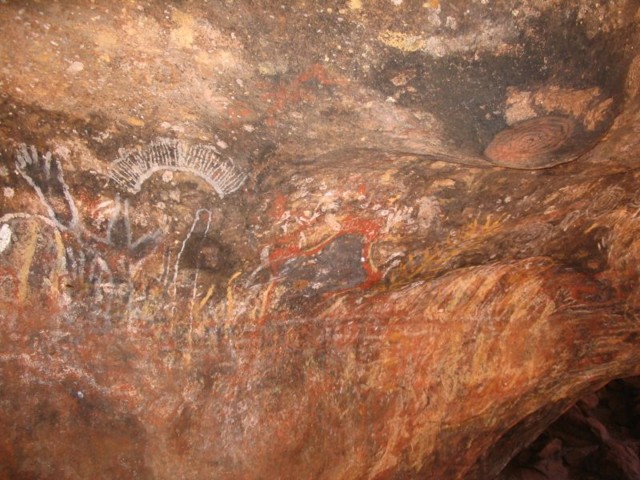

Nobody knows exactly who the Aborigines people are or where they came from. The only thing that seems certain about them is that they inhabited Australia, hunting, practicing horticulture and communicating with a written language that can still be read today at a time in pre-history when no other Homo-Sapiens is thought to have been able to master the necessary organization to even move from his own abode, much less migrate out of Africa, circumnavigate all trouble halfway around the globe, and finally cross a minimum of 50 kilometers of open waters (along the Torres Straits, which is the driest way to reach Australia) in order to reach this continent.
Take this for example:



This painting appears on one of the interior walls of a cave right under Uluru. Now, if you were an Aborigine from the Anangu tribe (accent on the first "n"), you would have been able to gather the following bits of information out of the painting, despite the fact that it dates roughly 10,000 years into the past:
Finally, the drawing includes many hand-prints. These are the signatures of the many Anangu who created this cave drawing. (There might have been more information there, but we had no Aborigines with us that day, so we had to make do with the very stilted reading abilities of our tour guides and our own eyes. Having an Aboriginal guide there could have made a world of difference.)
Prior to the arrival of European man, all of Australia was inhabited by Aborigines. Their view of Australia is very much like our view of Europe: the Aborigines see their tribes the way we see nations. Aboriginal tribes had clear territories and there was complex inter-tribal diplomacy between them.
Between tribes sharing a close territory, such as two neighboring tribes in the red centre, the writing is the same, even though the spoken language is different, so communication can be done by writing even when neither tribe understands the other's tongue. Between far away tribes, the writing symbols are completely different, too. Aboriginal writing is probably the oldest written symbols that have had a constant use and are still being used up to this very day.
It is sad, given all this glorious tradition, to think about all that's happened to Aborigines since the arrival of European man.
The history of Aborigines since European man has been short and brutal. As in many other places in the world, European man took one look at this ancient, glorious tradition, decided that these were all godless savages, and began a continent-wide genocide. It is not even 100 years since Aborigines were last considered legally to be fair game. Of the roughly 200 tribes (nations) that used to inhabit Australia, roughly 75% have no remaining survivors. Traditions as ancient as no others have been irrevocably lost, along with their languages, folk tales and writing.
Trying to make some amends, Europeans made things even worse. They first abducted fair-skinned Aboriginal children straight from their families in order to give them "a good Christian home". (This is now known as "The Lost Generation", a term that immediately brought the Yemen children to my mind.) Next, Europeans took entire Aboriginal tribes and relocated them to "places where they won't bother anyone", thus cutting them off from the land areas that they hold sacred and that they have been the keepers of for thousands of years. Worse, some of these sacred areas have been completely obliterated. The most famous example is lake Burley-Griffin in Canberra, the nation's capital. As part of the city's urban design, the shape of this lake has been altered completely, drowning the place that was for the traditional owners of the land the sacred meeting ground for men since time out of mind.
Carelessly bringing in new species of plants and animals to Australia, European man wreaked havoc even in areas that he could not inhabit. Millions of rabbits have raided the Australian outback, tearing plants from their roots and making a previously green landscape into a barren wasteland. European bees were introduced, driving away the friendly (unstinging) Australian bee. And more and more. Perhaps the most telling of these examples is the Spinifex grass. Spinifex was brought to Australia as stock feed, and its growth was abandoned as soon as it was clear that the stock didn't want to eat any. This, however, didn't stop spinifex from taking over the entire country. In aerial photographs of the Australian outback you can see giant fields of it, growing in characteristic circles.
The problem with the spinifex, aside from the fact that it competes with the local plants over the scarce water, is that it made the Aborigines' horticultural methods fail. When it burns, it burns at a much higher temperature than local plants, consequently burning them up along with their roots, not enabling any regrowth.
Continuing to try making amends, Europeans then stocked Aboriginal tribes with alcohol. Alcoholism is now the number one bane of the Aboriginal people. Furthermore, Australia not very long ago passed legislature that tries to make further amends by paying Aborigines large sums of money. This money, however, came too late and is sadly mostly used in order to buy more alcohol. Several Aboriginal tribes have already declared themselves to be dry communities and no alcohol is allowed anywhere within their area.
It is darn surprising, with all this amending going on, that there is anything left of Aborigines at all. Nevertheless, they managed to pull themselves together and live through the worst of it. Now, the Aborigines have equal voting rights in Australia. The Aborigine flag and the Torres Islander flag are both official flags of Australia. (There are also flags per tribe, in case you were wondering, and none of them date back more than 50 years.)
Most importantly, Aborigines have gradually regained autonomous rule over parts of the Australian land. This is of course only a drop in the ocean, and the Aborigines definitely want more, and this they express by maintaining a protest tent and a ceremonial fire burning right outside Australia's old parliament house. This is the so-called "Aboriginal embassy tent".
The "tent" has been out there for 33 years, and, as you understand, the going is slow, but I think that this is the thing that I found most wondrous about this whole sordid affair:
Imagine where the Afro-americans in the U.S. would have been, if they had continued for 33 years in peaceful, non-media-hogging protest. Probably, they would have been where the American Indians are. Imagine - and here you're going to really stretch your imagination - if anybody in the middle east, anybody at all, would have tried this sort of protest. What would be left of them?
Well, all I can say is that I wish the Aborigines well and admire their resolve to neither give up nor give in to the methods of European man. These men, whose ancestors never created any weapons of war nor waged any wars, despite the fact that they developed the greatest throwing weapons for use in hunting ever made (hunting tools that make use of sophisticated chemistry, as well as sophisticated physics. The boomerang, whose cross-section has for millenia been shaped like the cross-section of a modern airplane's wing, is but one example) - these men are giving pride to the traditions of their forefathers. That's all I'm saying. God help us all if they ever decide to change their ways.
But enough about politics. We also met some real, live Aborigines, such as this troupe of performers, that taught us about Aboriginal dances, music and body painting.
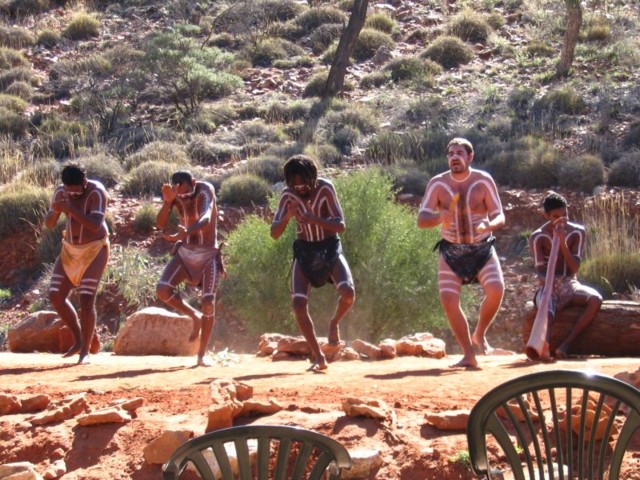
Aboriginal dances are much about teaching. Here, for example, is how Aborigines teach their children about gathering food.
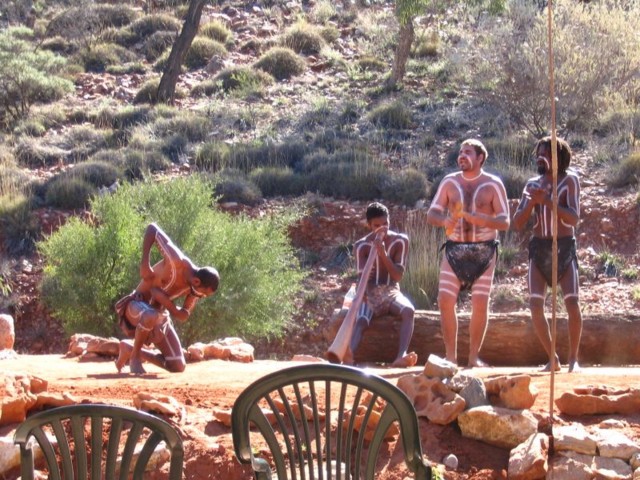
Here, a dancer is "doing the kangaroo". This is one part of a complex dance teaching hunting techniques.
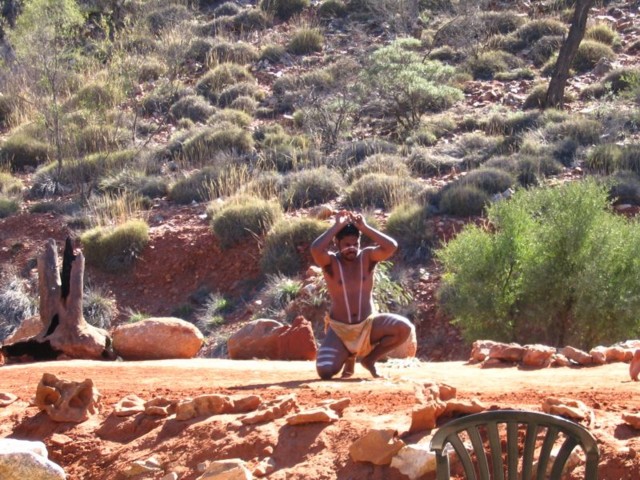
Here they are playing the digeridoo. This is a traditional instrument that the Aborigines call wiggi-wiggi. (The term "Digeridoo", just like "Kangaroo", is a European invention.) The digerido, or wiggi-wiggi, is a musical instrument made from the bark of a gum tree which had been eaten from the inside by termites. One end of this bark is then coated with bee's wax, making the mouth-piece. Traditionally, the sound of the digeridoo is created by the spirit of the tree. This is a male spirit, which is why women are not allowed to play the digeridoo.
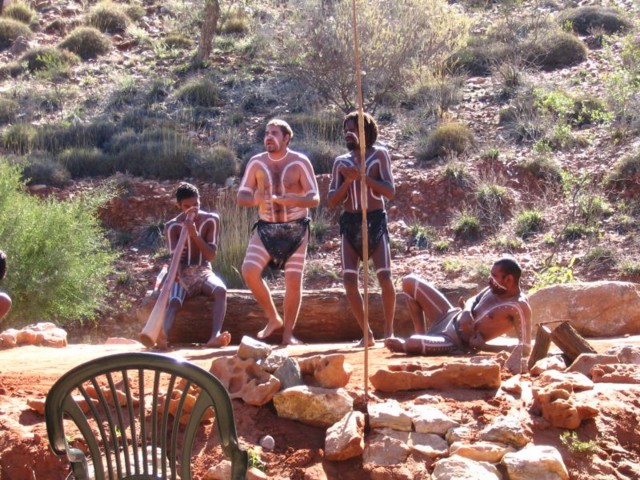
The thing that I found most unbelievable about the digeridoo is that Aborigines play it for minutes on end without taking in a breath of air. This is an instrument that requires you to blow very hard into it, in order to make a sound. Believe me: I tried.
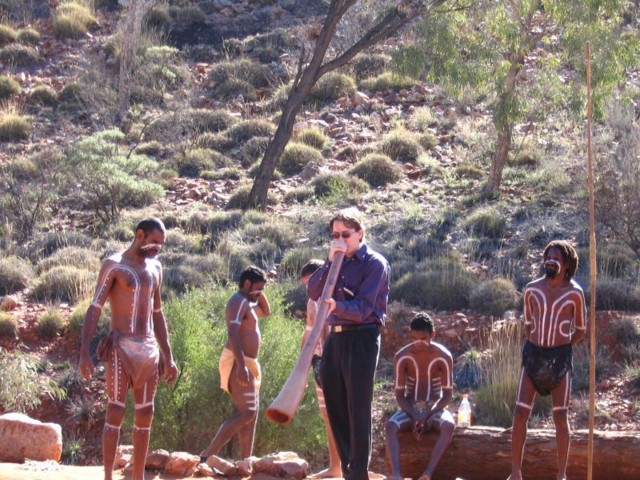
The way they manage to play without taking a breath is something called "circular breathing". They breathe in through their noses while simultaneously exhaling through their mouths, blowing into the digeridoo. This is a very neat trick, to say the least, and if I had not been there to witness it, I would have argued with great conviction that it is impossible and contradictory to all we know about the physics of the human anatomy.
In this next picture, what you see is a bunch of white men trying (quite miserably, if you ask me) to "do the Emu".
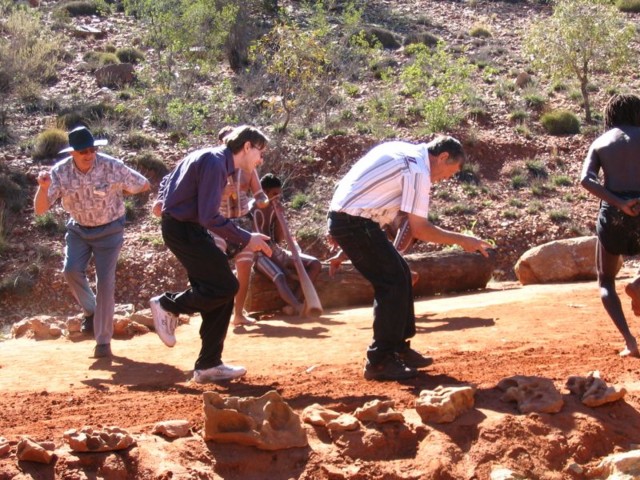
You be the judge.
And this last is my favorite picture. This is a very new Aboriginal dance.
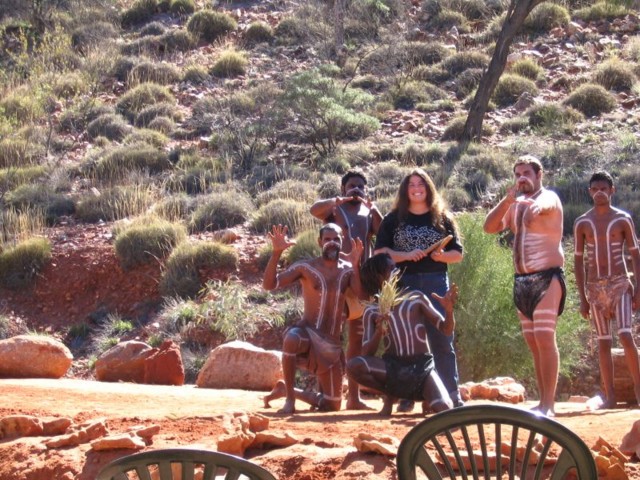
I call it: "doing the Tourist".